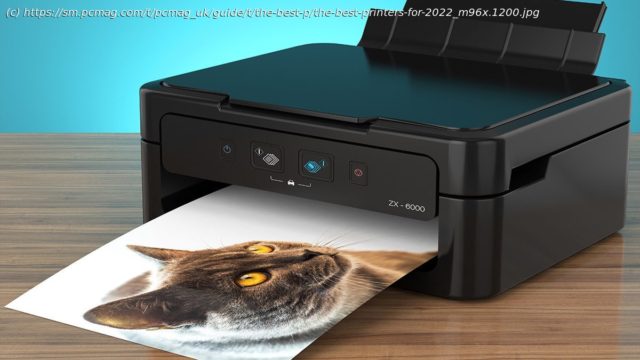Inkjet or laser? Need only printing, or scanning and copying, too? Seeking low-cost ink, or a low-cost printer? Here’s how to choose the right printer for home or work, backed by our top lab-tested picks.
Choosing a printer may sound easy, but once you start diving into all the available features, making a choice can quickly get daunting. Do you need a basic printer just to print, or do you want to scan and copy as well? And what about faxing, or scanning to and printing from the cloud, or even scanning and sending an email? How do you choose between inkjet and laser technology? What’s the real difference between a $200 model and a $500 model? Here are some pointers to help you find both the right category of printer and the right model within that type. How Do You Intend to Use Your Printer? Printers vary widely based on whether they’re for home use or business use (or dual use in a home and home office), what you intend to print with them, and whether you need color printing or just monochrome. In particular, text, graphics, and photos each require different capabilities to print at high quality. Even if you print just one kind of output most of the time, you also may want a printer that can do other things well. So be clear on the full scope of your printing needs before you buy. Most printers are designed with either business (usually office) or home use in mind. Generally, business models are geared toward outputting text if they are mono printers, and both text and graphics if they are color models. Home printers (typically inkjets) favor photos and often graphics, as well. Special-purpose options include label printers, portable printers, and dedicated and near-dedicated photo printers. (Even among specialty printers,3D printers are a special case, and beyond the scope of this discussion.) Do You Need Printing Only, or Multiple Functions? Most printers today add extra functions beyond printing. The additions always include scanning, which can be convenient and economical if you have light- to moderate-duty scanning needs. If you don’t need scanning or related features like copying and faxing at all, however, or your scanning needs are heavy-duty, you might be better off with a single-function printer and a separate scanner. Most lasers, and some inkjets, with extra functions include « multifunction printer » or « MFP » in the name, while most inkjets, and some lasers, use « all-in-one » or « AIO. » The two terms, and their acronyms, are interchangeable. Along with scanning, the additional functions almost always include some combination of standalone copying, standalone faxing, faxing from your PC, standalone emailing, emailing through your PC, and standalone copying to and printing from online systems. Office MFPs typically include an automatic document feeder (ADF) to handle multipage documents and legal-size pages. Many ADFs can handle two-sided documents—either by scanning one side and flipping the page over to scan the other side, or by employing two sensors to scan both sides of the page in a single pass. Some single-sided ADFs let you scan one side of a stack of pages, flip the stack manually to scan the other side, and then automatically interfile the pages in the right order. Some inkjet AIOs offer additional printing options, including printing on optical discs. Many let you print documents and images from, and scan to, mobile devices. Some models let you email documents to the printer from anywhere in the world, then print them out. Our roundup of the best all-in-one printers will help you sift through the many options out there. The Most Common Types of Printer Generally, business models use laser or similar technology (more on that shortly) and are geared toward text, or text and graphics, while home printers are generally inkjets and favor photos and graphics. Within each printer category, quality for each kind of output varies widely. Some business printers can handle all three types well enough for in-house printing of brochures and other marketing materials, for example. The two most common technologies, laser and inkjet, increasingly overlap in capabilities, but there are still differences. Most lasers and LED printers (which are identical to lasers other than using LEDs for a light source) print higher-quality text than most inkjets, and almost any inkjet prints higher-quality photos than most lasers. However, some inkjets today print text that’s nearly laser quality, except for a tendency to smudge if they get wet, while some lasers print photos at what’s known as business quality, which translates to good enough for a trifold brochure. Beyond questions of technology and output type, there are several more finely grained categories of printer. Home printers (approximate price range: $50 to $250) are almost exclusively inkjets (with the exception of some small-format dedicated photo printers). They are built for low-volume printing, tend to be slow, and also tend to have high ink costs. They typically print photos better than text, and may or may not print graphics well. Almost all of them are all-in-ones. If your budget is tight, and you want a single printer for text, graphics, and photos that handles photos reasonably well, this is where to start looking for an inexpensive printer. Home-office printers ($100 to $400) are largely inkjets or inexpensive mono lasers, and are built for low- to mid-volume printing. Most inkjets in this category are all-in-one printers, geared primarily toward text and graphics printing, though some also handle photos well, while most lasers are printers only. Paper capacity starts at about 100 sheets, though higher-end models can hold up to 500 sheets. Most of these printers are also suitable for micro offices (with up to five people), and many are perfectly fine choices for households, especially for students printing a lot of documents for school. Home-office printers are a subset of business printers ($100 to $2,500 or more), which range from compact models for low-volume use to gigantic floor-standing units that can anchor a department. Most business printers are lasers (though inkjets have been making inroads into that market for years), and many are monochrome, intended primarily for text rather than graphics and photos. Most are multifunction devices. For many businesses, speed and paper capacity are paramount, and security is important as well, which is why many business printers offer security features such as password-protected printing. Some even employ accessories such as an encrypted hard drive or an ID card reader to limit access to documents. Regardless of which home or business category a printer is in, cost can be a key factor. In general, the more expensive the printer, the lower its per-page printing costs, while the lower the ink price, the more expensive the printer will be. Whether you’ll save more with a low-cost printer or low-cost ink depends on how much you print (more on this later). Some printer makers also offer ink subscription programs that can lower running costs, particularly if you print close to the number of pages included in the plan.






